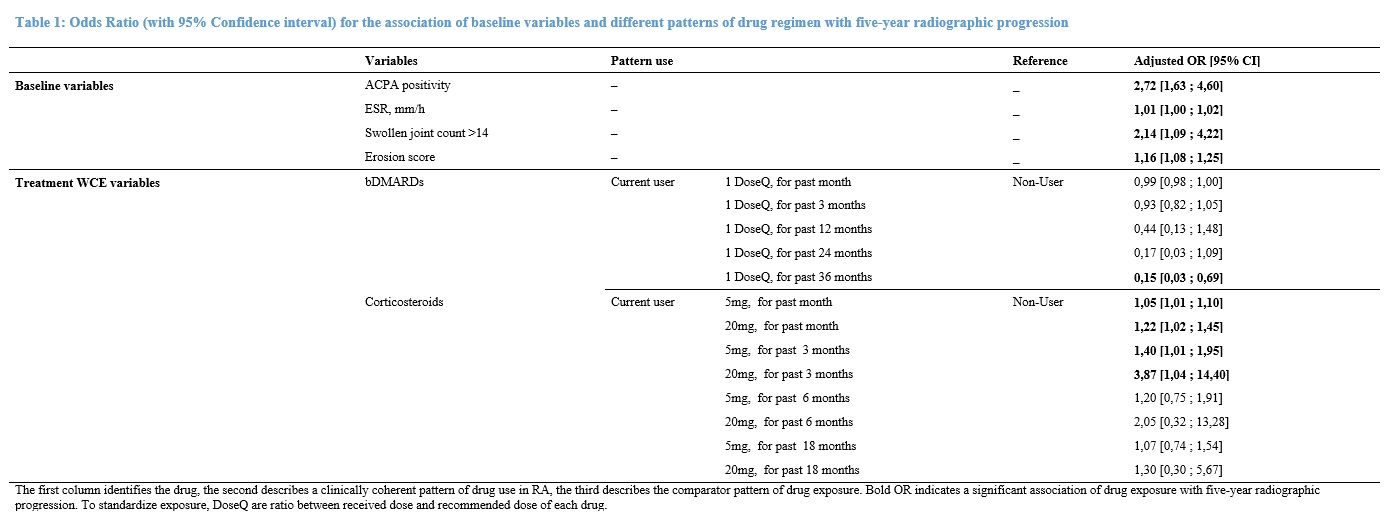Session Information
Date: Tuesday, November 7, 2017
Title: Rheumatoid Arthritis – Clinical Aspects Poster III: Comorbidities
Session Type: ACR Poster Session C
Session Time: 9:00AM-11:00AM
Background/Purpose: In rheumatoid arthritis (RA), a strategic approach to achieve low-disease activity or remission is now recommended. Controlling joint damage is thus an important concern in daily clinical practice and models are needed to assess predictive variables associated with radiographic progression. Nevertheless, the role of treatments regarding to this event has rarely been questioned and none of models built so far have properly considered exposition to treatments. Therapeutic regimens have often been described as a binary variable or as a mean dose which do not represent correctly drug exposure. In RA, treatment is composed of two types of drugs undergoing multiple switches and dose adjustments: 1) DMARDs and 2) Corticosteroids. If the risk of radiographic progression is related to factors of severity at diagnosis, predictive models must consider variables reflecting the complexity of drug exposure.
This study aims to develop a predictive model of five-year radiographic progression considering both baseline characteristics and time-varying drug exposure to corticosteroids and DMARDs.
Methods: Our study population was composed of 403 patients of the ESPOIR cohort with radiographic data at inclusion and at five years of follow-up and classified as RA at the inclusion visit according to the 1987 ACR and 2010 ACR/EULAR criteria. Radiographic progression was defined at 5 years as a change in the Sharp/van der Heidje score (vSHS) ≥ 5. A predictive model considering baseline characteristics and treatments as weighted cumulative exposure (WCE) variables was built. A WCE variable represents drug exposure as the weighted sum of past doses and is able to model complex profile of therapeutic regimens. It allowed the estimation of risks associated to different profiles of drug exposure with adjustments on baseline characteristics.
Results: Radiographic progression occurred in 35.5% (143/403) patients. The multivariate model included ACPA status, ESR, swollen joint count and erosion score as baseline predictors and corticosteroids, MTX/LEF and biological DMARDs (bDMARDs) as WCE variables. These baseline characteristics were consistent with the literature. Thirty-six months exposure to bDMARDs had a significant protective effect on radiographic progression. On the other hand, a significant deleterious effect was described for recent cumulative exposure (3 months or less) to corticosteroids (Table 1).
Conclusion: The analysis of therapeutic regimens as WCE variables brought new insights on the role of DMARDs and corticosteroids on radiographic progression. If the significant protective effect of bDMARDs has been confirmed, considering corticosteroids as a WCE variable demonstrated their deleterious effect on radiographic progression. Despite cautious consideration, these results contradict many clinical trials in which corticosteroids have been found protective.
To cite this abstract in AMA style:
Louveau B, De Rycke Y, Lafourcade A, Saraux A, Guillemin F, Tubach F, Fautrel B, Hajage D. Differential Effect of Corticosteroids and Biological Dmards on Five-Year Radiographic Progression in Rheumatoid Arthritis: Results from a Weighted Cumulative Exposure Model Developed on the Espoir Cohort [abstract]. Arthritis Rheumatol. 2017; 69 (suppl 10). https://acrabstracts.org/abstract/differential-effect-of-corticosteroids-and-biological-dmards-on-five-year-radiographic-progression-in-rheumatoid-arthritis-results-from-a-weighted-cumulative-exposure-model-developed-on-the-espoir-co/. Accessed .« Back to 2017 ACR/ARHP Annual Meeting
ACR Meeting Abstracts - https://acrabstracts.org/abstract/differential-effect-of-corticosteroids-and-biological-dmards-on-five-year-radiographic-progression-in-rheumatoid-arthritis-results-from-a-weighted-cumulative-exposure-model-developed-on-the-espoir-co/

